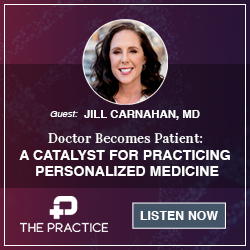
by Sara Gottfried, MD
Monday, 7:50 a.m. Cup of coffee in hand, I walked into my office and shut the door. I sat at my desk and reviewed my schedule of patients for the day. I was on call for my group of 14 obstetricians/gynecologists. There were 26 patients on the schedule, and several urgent slots remained open for the problems I’d triage throughout the day with the nurse manager and medical assistants. I could hear the clunk of messages being inserted into the inbox outside my door, mostly phone messages from patients who waited the weekend to deal with their bladder infections, positive pregnancy tests, vaginal bleeding on hormone therapy, left lower quadrant pain, and refills for their pain prescriptions.
My cell phone rings: “We have a patient down here in the emergency room with a positive pregnancy test and blood pressure 70 over palp.” Translation: ruptured ectopic, a life-threatening emergency, which means quick exam and consent to go to operating room for laparoscopy, possible laparotomy. As I race down to the ER, my cell phone rings again—this time, it’s my 10-year-old daughter. She just threw up, feels awful, and wants to be picked up immediately from school.
Does this sound familiar? It’s a typical day for a mainstream obstetrician/gynecologist, expected to be in multiple places at once—a prime set up for physician burnout. We know it’s worse for working mothers who tend to be responsible for more emotional labor within families. I was a few years beyond residency training, early thirties, married with one kid. My husband traveled a lot for business, and was out of town that day, so he couldn’t help me. At the time, my mental wellbeing was declining along with my job satisfaction, but I didn’t know it. I was burning out, and I couldn’t see it.
Burnout is a silent, insidious process. In fact, a recent study highlighted in The New York Times demonstrates that stress specific to physician training and practice negatively impacts doctors’ biology, in every cell with DNA, via telomere length shortening (a biologically quantifiable surrogate for cellular aging).1
Relentless workplace stress erodes health and identity until you’re a shell of who you once were. Burnout poisons relationships, including the one with yourself. The physician suicide rate “is much higher than the general public’s and even exceeds that of combat veterans,” wrote a medical director employing over 8,500 physicians.2 The physician suicide rate in the United States is climbing.3 Male doctors have a rate 40% higher than the national average, and female doctors commit suicide at a rate 130% higher than the national average.3
What causes physician burnout? Our institutions, “sickcare” system, patients, and ourselves as providers all play a role. This epidemic of physician burnout that has infiltrated our country not only has a negative impact on the physician themselves but also on the broader public.
Burnout is not a disease; it’s a cluster of symptoms that emerge from dysfunction. Physician burnout is multifactorial, in part a result of our pursuit of the science while stripping the humanity out of medicine, coupled with inhumane, sometimes abusive, work expectations. It leads to the downstream consequences of hypothalamic-pituitary-adrenal-thyroid-gonadal axis dysregulation, chronic stress, inflammation, and blood sugar abnormalities, all of which I experienced while still in the trenches of allopathic medicine.
We must acknowledge and honor the human elements that contribute to patient care and healing. In this article we’ll discuss how to reintroduce humanity to medicine. It requires thinking a bit “outside the box” and evolving the cultural norms in medicine. It’s an art, not a formula. We’ll help you identify the conditions that promote burnout and strategies you can employ to transform them into something that invigorates, rather than kills you. Because female physicians report burnout disproportionately and differently from men, we discuss this perspective in its own section.
Defining burnout
Burnout and depression have significant overlap. Burnout is distinct from depression, in that burnout is related to work, while depression is global.4 The PHQ-9 (a standard questionnaire for depression) can detect depression in the context of burnout.4 Using the Maslach Burnout Inventory (MBI) is a better way to differentiate the two.4
Burnout is a “syndrome… resulting from chronic workplace stress” recognized by the World Health Organization (WHO) as a reason someone seeks medical care.4 It was included in ICD-10 (Z73.0) and is further described in ICD-11 (QD85) as “workplace stress that has not been successfully managed. It is characterized by:5
- “Feelings of… exhaustion”
- “Increased mental distance… or feelings of negativism or cynicism related to one’s job”
- “Reduced professional efficacy”
The exhaustion of burnout may present as “headaches, chronic fatigue, gastrointestinal disorders, muscle tension, hypertension, cold/flu episodes, and sleep disturbances.”4
Stresses from institutional systems
The Mayo Clinic took a comprehensive look at its systems and burnout among its physicians and published its findings in a 2017 report.6 Clerical duties, such as charting, are among the most cited sources of frustration—no surprise there.6 Besides clerical duties, the Mayo Clinic report outlines several nonobvious factors that promote burnout, including an often unspoken belief that burnout is solely the responsibility of the physician. This framework usually leads doctors to seek solutions that benefit them personally but take away from the greater organization.6 Burnout is linked to turnover, and replacing a single physician can cost 200-300% his or her yearly salary—a 2017 report in JAMA Internal Medicine quotes the dollar amount can be $500,000-$1,000,000 to replace a full-time physician.6,7
Compensation, time off, debt
Doctors are more susceptible to overwork.6 Physicians are 4.5 times more likely to work over 60 hours per week than typical American workers.6 Medical training normalizes working such long hours. Accelerating the motive to work, doctors want to do all they can for their patients, and many healthcare providers graduate with six-figure student loan debt.8 I certainly did—like many of you—multiple six figures, and it took me until age 45 to pay them off.
Though paid time off is often included in employment agreements, many contracts have clauses that create a conflict for actually using that time.6 A JAMA report found physicians in production-based pay models were more likely to reduce their work effort than doctors who work for salary.7 The Mayo Clinic uses salary as compensation and cites evidence that a production-based pay model increases burnout risk among physicians.6
Leadership problems
The Mayo Clinic found many systems issues occurred at the level of department, and some burnout problems stemmed from department leaders.6 Leaders are often measured by production values, which can lead to neglect of the wellbeing of those they lead.6 The Mayo Clinic report found leadership accounts for 11% of burnout conditions and 47% of physician satisfaction.6
Social support and community at work
Dedicated spaces for physicians, such as doctors’ lounges, have largely been abandoned to create more equitable work environments.6 This has unintentionally contributed to the deterioration of physician peer support, and many doctors feel isolated from colleagues.6 Physicians identify with distinct professional identities, responsibilities, and challenges—thus peer support has always been an important factor in managing the stress of the job.5
Unique stresses for female physicians
Compared to men, female physicians are 60% more likely to report burnout.9 This suggests medical work environments stress women in unique ways. Controlling for multiple factors, a study of 2,300 men and women physicians found female physicians earned roughly $22,000 per year less than men.9 Only 26% of this variance was explained by variables such as specialty, number of hours worked per week, and insurance status of patients.9
Women practice differently
Women and men practice medicine differently.9 Compared to male physicians, females are more likely to work in primary care, counsel patients, and attend to psychosocial needs of their patients.9 Female doctors communicate differently with patients, and research has shown this can improve patient outcomes, improve patient retention in managed care plans, and reduce the likelihood of malpractice claims.9 One may wonder why women, who present with these unique assets to clinical practice, are paid less than men. In a system that measures the number of patients seen, resources utilized, and procedures performed, women appear to be less profitable than male clinicians.9 This is a short-term world view in a business model that is highly reliant on repeat services.
Lack of control at work
Lack of control in the workplace is a predictive factor for burnout in women, but not men.9 Female physicians report less control in patient load, scheduling, and referrals.9 Further, women feel a greater sense of time pressure when seeing patients, feeling they require 36% more time for new patients (male physicians need 21% more) and 24% more time for follow-ups (males need 9%).9 Each additional 5 hours of work per week increases the odds of burnout in women by 12-15%.9
Children and lack of spousal support
Given that women are typically burdened with more childcare responsibilities, one might predict having young children would increase burnout. Researchers find that having children under 6 years old does not predict burnout; however, if female physicians lack spousal support, risk increases by 40%.9
Stress with patients
Medical training, work hours, and maintaining an active license are demanding on their own. Medical knowledge doubles every 80 days, so staying on top of the medical literature is impossible, and another source of stress. Difficult patient encounters add to this stress. In the past, studies of such encounters have used discriminatory language toward the patients, describing them as “difficult, heartsink, black holes, etc.”10 This sort of language is stigmatizing and absolves the clinician of responsibility. The reality is that both the patient and doctor contribute to the difficulty of these encounters.10,11 A 2009 Archives of Internal Medicine study estimates 1 in 6 (17%) primary care encounters fit the description of “difficult.”10 In busy practices this means each physician has several visits each day that are particularly more difficult than the baseline stress of practicing.
What frustrates physicians?
Patients can frustrate us when they ignore our treatment recommendations, demand unnecessary treatments and testing, engage in behaviors that contribute to their poor health, and communicate rudely.12 We commonly describe encounters as difficult when they’re with patients who present frequently (especially if they neglect our advice) and those with psychological disorders, including mood and somatization symptoms.10,12 Patients with borderline or dependent personality disorders, substance addictions, unrealistic expectations, and manipulative behaviors can also contribute to difficult encounters.13 Also, patients using cell phones in the clinic can present ethical dilemmas.14
Who has more difficult encounters?
A 2017 article in AMA Journal of Ethics reports physicians with more difficult encounters report negative attitudes about psychosocial aspects of practice.11 Doctors with more difficult patient encounters perceive their workload to be greater and are less satisfied with their work.11 They are less likely to be trained in communication skills and counseling.11
Personal qualities of physicians can influence the special nature of the work, and contribute to burnout.11 Race, ethnicity, gender, and sexual orientation of the doctor and/or patient can influence medical interactions, and failure to recognize them can lead to difficult encounters.11 Physicians with “limited self-awareness…discomfort with uncertainty and…inability to set professional and personal boundaries” are at higher risk for burnout.10 Younger doctors report having more difficult encounters.10
Perceived threats to professional competency expose physicians to burnout.13 In this respect patients with complex needs, conflicting personalities, and challenging communication styles are likely to lead to difficult encounters.13 Conscious or unconscious negative biases toward specific health conditions have the potential to make encounters more difficult.13
Strategies to manage burnout conditions
Physician burnout is a problem with lethal consequences; however, it has been poorly characterized, the burden of responsibility has been shouldered by doctors suffering from it, and efforts to combat it have been half-hearted.
Since many conditions that contribute to burnout can be solved from the administrative level, it’s valuable to highlight the extreme economic costs burnout has on an organization and use this as leverage for better working conditions. A JAMA article provides a worksheet for organizations to determine the dollar amount worth investing in burnout prevention/mitigation.7 Both Mayo Clinic and JAMA recommend addressing changes to burnout conditions mostly on departmental/division levels to meet the specific needs and maximize return on investment.6,7
Additionally, physicians need to be provided with objective data on their own wellbeing so that they might acknowledge feelings that have been suppressed due to cultural norms and embark on behavioral change.6 The inverse of burnout is engagement—characterized by absorption in work and vitality.6
Compensation, time off, debt
First, women deserve equal pay for equal work. In a production-based compensation model, consider the benefits of salary with regard to burnout.6 Alternatively, basing part of compensation on quality measures such as patient satisfaction is an alternative; although this could also lead to overwork.6 Student loan repayment/forgiveness programs can be valuable recruiting and retention benefits, as this form of compensation avoids increased income tax.8
Organizations that cultivate a culture of wellness are likely to see the greatest return on their investments.7 Employees should be encouraged to use their earned vacation time, train in mindfulness, and utilize preventative health services.6,7
Leadership
Leaders need to be regularly (and preferably anonymously) evaluated by those they lead.6 The competencies (including human interaction skills) of leaders must be critically evaluated before being given the authority to head a department/division.5 “Term limits” are a useful strategy to ensure continual adaptation.6 Leaders should get to know the individuals they lead and allow them to spend 20% of their work time in a “professional activity that motivates them.”6 This has been shown to significantly reduce burnout and ensures at least 80% of their time is spent on organization-directed work needs.6
Social support and community at work
Peer support is an incredibly important factor for physicians to minimize burnout.6,7,9 Physician groups, such as Balint groups, that meet regularly to discuss challenges in practice can help with feelings of peer support and self-awareness in clinical encounters.6,11 A “burnout-protective” work community is one that acknowledges and celebrates personal and professional achievements and supports physicians through tough times such as a malpractice suit or loss of a patient.6 Colleague support reduces burnout risk by 45% in female clinicians.9
Practitioner-specific preferences
Considering female physicians may prefer to utilize more time with their patients, and time pressure is a significant burnout factor, patient scheduling should account for practitioner-specific preferences.9,11
Risk assessment is routinely part of business decisions. Organizations would be wise to economically value attributes female clinicians perform higher on such as patient satisfaction/outcomes, retention, and decreased risk of malpractice claims.9 This will likely reflect the true profitability of female clinicians.
Control at work
Flexibility on working hours allows physicians to meet personal responsibilities and reduces burnout.6 The Mayo Clinic found allowing physicians to choose their start and end times for workdays helped to retain full-time clinicians, rather than having them drop to part-time.6 Also distributing their hours on different days (having a short workday offset by a longer workday) allows more work-life balance.6 They found barriers such as scheduling are easily resolvable when discussing as a team.6 Allowing doctors to work less (with appropriate reduction in pay) and with greater flexibility not only gives a sense of control, but can facilitate recovery from burnout in those already suffering.6
Spousal support
Spousal support can be especially helpful for preventing burnout in female clinicians with children (40% lower burnout risk), so efforts should be made to ensure they have adequate time to foster these relationships.9
Diffusing difficult encounters
Some patient encounters will trigger negative feelings. Self-awareness of these feelings can be an important step to diffusing them.13 Though medical schools should teach these skills uniformly, pursuing additional training in motivational interviewing, counseling, and other empathic listening skills can help to navigate and direct difficult patient encounters.11,13 Familiarizing yourself and developing an interest with the psychosocial aspects of disease may help connect with patients with complex medical needs.11 Beginning visits with expectations of time and acceptable behavior can avoid surprises that lead to emotional escalation.13,14
Cultural awareness of your patient and yourself can be valuable knowledge to avoid difficult encounters and understand your patients’ perceptions.11 Understanding and exploring your own biases has the potential to widen your empathy and decrease negative reactivity to particular patients and interactions.13
Conclusion
Burnout is not your fate. Our healthcare systems are broken, but as leaders and participants in those systems, we have a responsibility to repair them. Inhumane working conditions don’t have to persist. However, we must take action to end them. That takes curiosity, hope, and collaboration. My hope is that you will use the strategies in this article to renegotiate working terms for your life and your colleagues’ lives. Ideally, I’d like for you to join the conversation and create new solutions, so we can add them to our list of evidence-based strategies that prevent and reverse burnout.
Your patients need you to stay in practice, brimming with the enthusiasm and wellbeing that fueled you through medical training. Cultural change occurs when we demand it. Administrative policies that maintain hostile working conditions must be called out and defeated. We must speak our truth as physicians—given the risks and dire suicide rates, our lives depend on it.
Citations
- Ridout KK et al. Physician-training stress and accelerated cellular aging. Biol Psychiatry. 2019;S0006-3223(19)31329-0.
- Huang P. NPR. What’s doctor burnout costing America? https://www.npr.org/sections/health-shots/2019/05/31/728334635/whats-doctor-burnout-costing-america. Accessed June 21, 2019.
- California Medical Association. CMA Doc: Edward Ellison, MD. https://www.cmadocs.org/newsroom/news/view/ArticleId/20919/CMA-Doc-Edward-Ellison-M-D. Accessed June 21, 2019.
- Maslach C et al. Understanding the burnout experience: recent research and its implications for psychiatry. World Psychiatry. 2016;15(2):103-111.
- Burn-out an “occupational phenomenon”: International Classification of Diseases. https://www.who.int/mental_health/evidence/burn-out/en/. Accessed 6/21/2019.
- Shanafelt TD et al. Executive leadership and physician well-being: nine organizational strategies to promote engagement and reduce burnout. Mayo Clin Proc. 2017;92(1):129-146.
- Shanafelt TD et al. The business case for investing in physician well-being. JAMA Intern Med. 2017;177(12):1826-1832.
- Nykiel T. Nerdwallet. 8 medical school loan forgiveness programs. https://www.nerdwallet.com/blog/loans/student-loans/medical-school-loan-forgiveness-programs/. Accessed June 21, 2019.9.
- McMurray JE et al. The work lives of women physicians results from the physician work life study. The SGIM Career satisfaction study group. J Gen Intern Med. 2000;15(6):372-380.10.
- Kroenke K. Unburdening the difficult clinical encounter. Arch Intern Med. 2009;169(4):333-334. 11.
- Goldsmith ES et al. Roles of physicians and health care systems in “difficult” clinical encounters. AMA J Ethics. 2017;19(4):381-390.
- An PG et al. Does a higher frequency of difficult patient encounters lead to lower quality care? J Fam Pract. 2013;62(1):24–29.
- Cannarella-Lorenzetti R et al. Managing difficult encounters: understanding physician, patient, and situational factors. Am Fam Physician. 2013;87(6):419-425.
- DeWane M et al. Cell phone use in the clinic: “please hang up now, the doctor is ready to see you!” Int J Womens Dermatol. 2018;4(4):238–239.
Sara Gottfried, MD is a board-certified gynecologist and physician scientist. She graduated from Harvard Medical School and the Massachusetts Institute of Technology and completed residency at the University of California at San Francisco. Over the past two decades, Dr. Gottfried has seen more than 25,000 patients and specializes in identifying the underlying cause of her patients’ conditions to achieve true and lasting health transformations, not just symptom management.
Dr. Gottfried is a global keynote speaker who practices evidence-based integrative, precision, and Functional Medicine. She recently published a new book, Brain Body Diet and has also authored three New York Times bestselling books: The Hormone Cure, The Hormone Reset Diet, and Younger.






